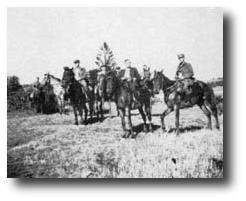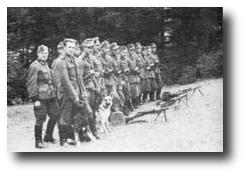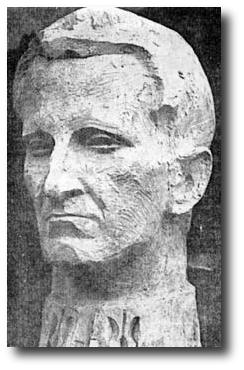![[LITOPYS UPA: Chronicle of the Ukrainian Insurgent Army]](/upa/images/litopys.jpg)
SERIES 1
VOLUME 10
![[LITOPYS UPA: Chronicle of the Ukrainian Insurgent Army]](/upa/images/litopys.jpg)

 This third volume of Litopys UPA relating to the Supreme Ukrainian
Liberation Council (UHVR) includes documents and materials from
1949-52. The basic materials from that period were published
underground in Ukraine in the official bulletin of the UHVR the
Information Bureau of the Supreme Ukrainian Liberation Council (UHVR),
Nos. 4-7 and 9. from March and November, 1949, February and March,
1950, and May, 1951. The eighth issue of the bulletin Information
Bureau is not available in the West. The bulletins are here reprinted
in their entirety, in the same order as they appeared in Ukraine.
This third volume of Litopys UPA relating to the Supreme Ukrainian
Liberation Council (UHVR) includes documents and materials from
1949-52. The basic materials from that period were published
underground in Ukraine in the official bulletin of the UHVR the
Information Bureau of the Supreme Ukrainian Liberation Council (UHVR),
Nos. 4-7 and 9. from March and November, 1949, February and March,
1950, and May, 1951. The eighth issue of the bulletin Information
Bureau is not available in the West. The bulletins are here reprinted
in their entirety, in the same order as they appeared in Ukraine.
This volume also includes other documents from the same period. Most important among them is the "Appeal of Warring Ukraine to All Ukrainians Living Abroad, "published in October, I949, and signed by 22 prominent members of the Ukrainian armed resistance, including four people identified as representatives of the the UHVR - Brigadier-General R. Lozovskyi-Chuprynka, Chairman of the General Secretariat of the UHVR; Colonel V. Koval, Vice-Chairman of the General Secretariat of the UHVR; and (Prof. N. Zelenyi, and Rev. Prof. Lavrivskyi members of the UHVR. Another long document is a letter from P. Poltava to the U. S. Senate Department, "Voice of America," Ukrainian Service - "Some, suggestions Regarding 'Voice of America' Radio Broadcasts to the Soviet Union". The letter was official, signed by Poltava as a Major of the UPA and Director of the UHVR Information Bureau in Ukraine. The letter was sent via the Foreign Representation of the UHVR. The volume also contains UHVR resolutions and announcements which were not published in official UHVR publications known in the West. Among these documents are official notification of the death in battle of the Chairman of the General Secretariat of the UHVR and Supreme Commander of the UPA, Brigadier General Roman Shukhevych ( R. Lozovskyi, Taras Chuprynka) and the Vice-Chairman of the General Secretariat of the UHVR, 0syp Diakiv ( O. Hornovyi).
Also reprinted in this volume are four underground articles that relate directly to the UHVR or the entire Ukrainian liberation movement at that time. The polemical article "About the Supreme Ukrainian Liberation Council" is of interest as the reaction of an unknown underground author to criticisms made of the UHVR by some emigre Ukrainian journalists. Equally interesting is the article by Vsevolod Ramzenko, "Why We Stand for an Independent, United Ukrainian State," for it provides a fresh justification of the fundamental goal of the Ukrainian nationalist movement. In addition, the article stands as a good example of underground publications aimed at the masses: the author strives to explain complex matters in a way that is understandable to peasants and workers. Of prime importance are two articles by P. Poltava "The Direct Aims of Our Struggle" and "Our Plan of Battle for the Liberation of Ukraine under the Present Circumstances." As their titles indicate, these articles discuss the future prospects of the Ukrainian armed resistance, its strategy and its tactics.
 The documents included in this volume come from the last period of
UHVR activity in Ukraine. On March 5, 1950, in the village of
Bilohorshcha near Lviv, Brigadier-General Roman Shukhevych (Taras
Chuprynka), Chairman of the General Secretariat of the UHVR and
Supreme Commander of the UPA, was killed in battle with NKVD
troops. His place was taken by Colonel Vasyl Kuk (V. Koval), who
remained active for almost four more years. At the end of 1953, he
fell into the hands of the Soviet state security agents; exactly how
this happened is not known. Later, a typically-Soviet-style
recantation, signed by him, appeared, in which he denounced his
previous activities. In the meanwhile, several other chief UHVR
activists also perished. On November 20, 1950, the Vice-Chairman of
the UHVR General Secretariat, Captain Osyp Diakiv (O. Hornovyi) was
killed in battle with the NKVD near the village of Velyke Pole,
Ivano-Frankivsk raion, Lviv oblast. In the winter of 1951-52, Major
P. Poltava, chief publicist of the armed resistance and at the time,
Vice-Chairman of the General Secretariat of the UHVR, was killed in
the Carpathian Mountains. The exact details of his passing are not
known. In the spring of 1953 Wasyl Okhrymovych, member of the UHVR,
was taken captive by the NKVD. The full details of his capture are
also unknown. Kiev radio and other sources of Soviet propaganda later
announced that on May 19, 1954, the military tribunal of the Kiev
military region had sentenced Okhrymovych to death by firing squad and
that the sentence had been carried out. Concerning other prominent
members of the UHVR in Ukraine - either their fates remain unknown, as
in the case of Prof. "Zelenyi", or considerations for their safety
dictate that nothing be written about them. In any case, after 1953
the link between the UHVR in Ukraine and the emigre Ukrainian
community was broken. the last UHVR documents to be received abroad
date from the year 1952.
The documents included in this volume come from the last period of
UHVR activity in Ukraine. On March 5, 1950, in the village of
Bilohorshcha near Lviv, Brigadier-General Roman Shukhevych (Taras
Chuprynka), Chairman of the General Secretariat of the UHVR and
Supreme Commander of the UPA, was killed in battle with NKVD
troops. His place was taken by Colonel Vasyl Kuk (V. Koval), who
remained active for almost four more years. At the end of 1953, he
fell into the hands of the Soviet state security agents; exactly how
this happened is not known. Later, a typically-Soviet-style
recantation, signed by him, appeared, in which he denounced his
previous activities. In the meanwhile, several other chief UHVR
activists also perished. On November 20, 1950, the Vice-Chairman of
the UHVR General Secretariat, Captain Osyp Diakiv (O. Hornovyi) was
killed in battle with the NKVD near the village of Velyke Pole,
Ivano-Frankivsk raion, Lviv oblast. In the winter of 1951-52, Major
P. Poltava, chief publicist of the armed resistance and at the time,
Vice-Chairman of the General Secretariat of the UHVR, was killed in
the Carpathian Mountains. The exact details of his passing are not
known. In the spring of 1953 Wasyl Okhrymovych, member of the UHVR,
was taken captive by the NKVD. The full details of his capture are
also unknown. Kiev radio and other sources of Soviet propaganda later
announced that on May 19, 1954, the military tribunal of the Kiev
military region had sentenced Okhrymovych to death by firing squad and
that the sentence had been carried out. Concerning other prominent
members of the UHVR in Ukraine - either their fates remain unknown, as
in the case of Prof. "Zelenyi", or considerations for their safety
dictate that nothing be written about them. In any case, after 1953
the link between the UHVR in Ukraine and the emigre Ukrainian
community was broken. the last UHVR documents to be received abroad
date from the year 1952.
The destruction of the central political leadership of the UHVR did not bring an end to the Ukrainian armed resistance. This is obvious even from Soviet sources. It is true that following the appeal issued by M. Kovalchuk, Minister of Internal Affairs of the Ukrainian SSR, on December 30, 1949, calling on Ukrainian insurgents to "step forward with their offences," no more appeals came from the Soviet Ukrainian government. However, local appeals of this nature continued to be issued, in particular by oblast administrations (the last such known to be made appeared in the Rivne Chervonyi Prapor on February 10, 1956). Furthermore, at the 19-th Congress of the Communist Party of Ukraine, in 1954, the First Secretary of the party, O. I. Kyrychenho, called in his speech for an ultimate destruction of the armed underground and warned against the danger of nationalists infiltrating the Soviet government apparatus As late as in the second half of the 1950, information continued to arrive from Soviet and other sources concerning discoveries by the Soviet police of hideouts of underground activists and the destruction by the police of underground centres.
The materials included in this volume do not indicate that the resistance movement was about to run out of steam. on the contrary - the documents maintain an optimistic spirit, in spite of the fact that they describe the ruthlessness of the Soviet police in combating the underground and speak of the great losses of life suffered by underground cadres and the Ukrainian population as a whole. For example, the article by P. Poltava, "Our Plan of Battle for the Liberation of Ukraine under the Present Circumstances,' written in 1951, speaks of the underground's long-term plan for armed resistance. Poltava was convinced that in the conditions of the Soviet totalitarian police state, the Ukrainian movement of armed resistance would be able to survive for many pears and that its dynamic, progressive program would finally bring about the downfall of the Soviet empire. Poltava's optimism was based on current knowledge about the breadth and activities of the Ukrainian armed resistance after the time of its transformation from insurgent form of battle to underground conspiratorial activity. Poltava wrote in his article that regardless of the Soviet police terror and the losses thus engendered, the scope of the struggle did not shrink, but rather widened. Unfortunately, accessible documentation of the activities of the armed underground is limited to only the first half of 1949. We have in mind here the account "Battle actions of the UPA and the armed underground in Ukraine under Russian Bolshevik occupation (in the USSR)", published in the seventh issue of the bulletin Information Bureau, dated March, 1950. (The bulletin is reprinted in this issue of Litopys UPA). The eighth issue of the bulletin, which probably contained accounts of armed actions carried out by UPA and the underground during the second half of 1949, is not available. Accounts of defensive and offensive armed actions waged by the UPA and the armed underground in 1948 were published in the fifth and sixth issues of the Information Bureau, dated November, 1949, and February, 1950. Those issues are reprinted in this volume.
 The accounts of armed actions give us very concrete data about the
locations and character of the underground's bottle
operations. According to the summary prepared by Stepan Daryliuk, the
following numbers of operations took place in 1948 in individual
oblasts: Volyn - 42, Drohobych - 387, Kamianets Podilskyi - 8, Kiev -
2, Lviv - 274, Rivne - 67, Stanyslaviv - 344, Ternopil - 282,
Chernihiv - 2, Chernivtsi - 12, Brest (Byelorussian SSR) - 2, ("A
Summary of the Military Achievements of the UPA and the Armed
Underground," Do Zbroi, No. 19. June, 1953, p. 8). Naturally, the
accounts of actions are incomplete, for many encounters remained
unreported for various reasons; furthermore, some reports were lost
because the couriers carrying them to the offices of the Information
Bureau were killed along the way. The introduction to the account of
UPA and armed underground battle operations for the second half of
1948 states that "The underground and the UPA have their own press and
late tens of thousands of brochures and hundreds of thousands of
anti-Soviet leaflets, notices and placards; they also carry on their
educational propaganda activities on a word-of-mouth basis often
organize mass meetings." Information Bureau of the 5 Ukrainian
Liberation Council (UHVR) No. 6, February, 1950).
The accounts of armed actions give us very concrete data about the
locations and character of the underground's bottle
operations. According to the summary prepared by Stepan Daryliuk, the
following numbers of operations took place in 1948 in individual
oblasts: Volyn - 42, Drohobych - 387, Kamianets Podilskyi - 8, Kiev -
2, Lviv - 274, Rivne - 67, Stanyslaviv - 344, Ternopil - 282,
Chernihiv - 2, Chernivtsi - 12, Brest (Byelorussian SSR) - 2, ("A
Summary of the Military Achievements of the UPA and the Armed
Underground," Do Zbroi, No. 19. June, 1953, p. 8). Naturally, the
accounts of actions are incomplete, for many encounters remained
unreported for various reasons; furthermore, some reports were lost
because the couriers carrying them to the offices of the Information
Bureau were killed along the way. The introduction to the account of
UPA and armed underground battle operations for the second half of
1948 states that "The underground and the UPA have their own press and
late tens of thousands of brochures and hundreds of thousands of
anti-Soviet leaflets, notices and placards; they also carry on their
educational propaganda activities on a word-of-mouth basis often
organize mass meetings." Information Bureau of the 5 Ukrainian
Liberation Council (UHVR) No. 6, February, 1950).
In the materials and documents published in this volume there is much talk about the gradual transformation of liberation movement, during the years 1946-49, from an armed struggle to one acting in secret in the underground. During th years of the Soviet occupation, in the thinly-forested regions of Ukraine UPA units were reorganized into platoons, squads even smaller groups, in order to pass the period of massive raids and blockades hiding out in underground bunkers or the general population. The same tactic was used during the of 1945-46, when NKVD troops organized a massive blockade lasting several months, of all the villages and larger forested areas within the territory of UPA activity. Thanks to this tactic blockade did not achieve the effect desired by the Soviets. While it is true that the UPA and the armed underground suffered serious losses, they were not destroyed. The local centres of the underground continued to function. Later, units of the UPA Were banded, particularly in areas that lacked good forest cover and their members were sent to fill gaps or strengthen the armed underground.
In areas such as these the UPA units had to act in smaller groups, such as squads and cells, because of the relentless pressure of the superior forces of the NKVD. Thus, documents from this period state that in 1948 and 1949, UPA units remained intact in the region of the Carpathian Mountains. The end of 1949 must be regarded as, formally, the end of the UPA's activities. The previously-unpublished "Order No. 2" issued by the Supreme Command on September 3, 1949, states that "With the end of 1949, the activities of all UPA units and Command staffs temporarily cease." The order was based on "the decision by the UHVR on August 29, 1949," and was signed by Brigadier General Taras Chuprynka ("Order No. 2." Carbon copy of the original. Archive of the ZP UHVR,) By the end of 1949, the last units and Command staffs of the UPA were to be disbanded, while the organizational personnel staff of the UPA was to be transferred to equivalent levels of leadership of the armed underground. The UPA staff retained the right-to designate as officers and non-commissioned officers members of the armed underground. Thus, at the start of 1950, only one apparatus of armed resistance remained, whose cadres and leadership were made up of OUN members, former UPA soldiers and people who did not adhere to any political grouping, including some former members of political parties that had been active in the past.
One document that stands out from the others published in this volume is the ninth issue of the bulletin Information Bureau, dated May, 1951. At the time the Korean War was raging. This international conflict threatened to escalate into World War Three between the democratic countries of the West and the Soviet bloc. Thus, the ninth issue of the bulletin is devoted to a discussion of the possibility of world war. The issue includes an article by P. Poltava, "Preparations for the Third World War and the Tasks of the Ukrainian People", in which he discusses the question of war and peace, and sketches out a general plan for taking advantage of the impending war in order to build an independent Ukrainian state. Also published in this issue of the bulletin is an interesting appeal from the UPA Supreme Command, entitled "To Ukrainian Soldiers and Commanders in the Soviet Army," which instructs soldiers of the Red Army how to behave should a new war break out.
The materials and photographs used in this volume were obtained from the Archive of the ZP UHVR, except for photographs which have other sources indicated in the captions. Materials are reprinted without any omissions, except for corrections of printing and spelling errors and of the most serious mistakes of grammar. The editors thank wholeheartedly the directors of the Archive and everyone else who contributed to the preparation of this volume of Litopys UPA. In particular, we thank Mykola Lebed and Petro Sodol for their assistance in gathering materials and other needed information, Antin Ivakhniak for his corrections of the texts, Volodymyr Makar for assistance in proofreading, Zonia Keywan, for doing translations into English, and Stepan Shpak for his assistance in compiling the index.
Yevhen Shtendera
Petro J. Potichnyj